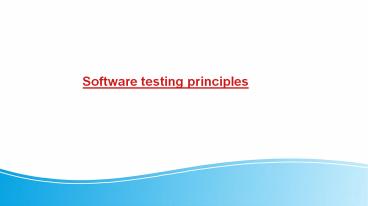Software testing principles PowerPoint PPT Presentation
Title: Software testing principles
1
Software testing principles
2
- INDEX
- 1) an exhaustive examination is not possible
- 2) Lack Clustering
- 3) Pesticide Paradox
- 4) examination shows a presence of defects
- 5) lack of error-fallacy
- 6) Early Tests
- 7) testing depends on context
3
https//www.exltech.in/software-testing-course.htm
l
4
Software testing Principles 1) an exhaustive
examination is not possible A comprehensive
examination is not possible. Instead, we need the
optimal amount of Tests based on the risk
assessment of the application.
5
2) Lack Clustering Defect Clustering, which means
that a small number of modules contain most of
the defects found. This is the application of the
Pareto principle to software testing
approximately 80 of the problems are found in
20 of the modules. By experience you can
identify such risky modules. But this approach
has its own problems If the same tests are
repeated again and again, the same test cases
will eventually no longer find any new errors.
6
3) Pesticide Paradox The repeated use of the same
pesticide mixture for the eradication of insects
during agriculture leads over time to the fact
that insects develop resistance to the pesticide,
whereby pesticides on insects become ineffective.
The same applies to software testing. If the same
repeated tests are performed, the method is
useless to discover new defects. To overcome
this, the test cases need to be reviewed and
revised regularly, adding new different test
cases to find more defects.
7
4) examination shows a presence of
defects Therefore, test principle states
that-Test speaks about the presence of defects
and does not talk about the absence of defects.
this means that software testing reduces the
likelihood that undetected defects remain in the
software, but even if no defects are found, it is
not proof of correctness.
8
5) lack of error-fallacy It is possible that
Software that is 99 error free is still
unusable. This can be the case if the system is
thoroughly tested for the incorrect requirement.
Software testing is not only the discovery of
defects, but also the verification that software
meets the business needs. The absence of an error
is an error, i.e. finding and correcting errors
does not help if the system structure is unusable
and does not meet the requirements of the user.
9
6) Early Tests Early Test Tests should start as
early as possible in the software development
lifecycle. In order to detect any defects in the
requirements or design phase at an early stage.
It is much cheaper to fix a defect in the early
stages of testing. But how early should one start
testing? It is recommended that you find the
error as soon as the requirements are defined.
10
7) testing depends on context Testing is
context-sensitive, which basically means that the
way you test an e-commerce Website is different
from the way you test a commercial off-the-shelf
application. All developed software are not
identical. You can use a different approach,
methods, techniques, and types of Tests,
depending on the type of application. For
example, testing every POS system in a retail
store will be different from testing an ATM
machine.
11
For more detailshttps//www.exltech.in/

